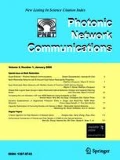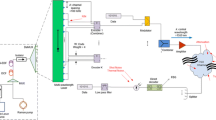Abstract
The optical code division multiple access (OCDMA), the most advanced multiple access technology in optical communication has become significant and gaining popularity because of its asynchronous access capability, faster speed, efficiency, security and unlimited bandwidth. Many codes are developed in spectral amplitude coding optical code division multiple access (SAC-OCDMA) with zero or minimum cross-correlation properties to reduce the multiple access interference (MAI) and Phase Induced Intensity Noise (PIIN). This paper compares two novel SAC-OCDMA codes in terms of their performances such as bit error rate (BER), number of active users that is accommodated with minimum cross-correlation property, high data rate that is achievable and the minimum power that the OCDMA system supports to achieve a minimum BER value. One of the proposed novel codes referred in this work as modified random diagonal code (MRDC) possesses cross-correlation between zero to one and the second novel code referred in this work as modified new zero cross-correlation code (MNZCC) possesses cross-correlation zero to further minimize the multiple access interference, which are found to be more scalable compared to the other existing SAC-OCDMA codes. In this work, the proposed MRDC and MNZCC codes are implemented in an optical system using the optisystem version-12 software for the SAC-OCDMA scheme. Simulation results depict that the OCDMA system based on the proposed novel MNZCC code exhibits better performance compared to the MRDC code and former existing SAC-OCDMA codes. The proposed MNZCC code accommodates maximum number of simultaneous users with higher data rate transmission, lower BER and longer traveling distance without any signal quality degradation as compared to the former existing SAC-OCDMA codes.














Similar content being viewed by others
References
Abd, T.H., et al.: Development of a new code family based on SAC-OCDMA system with large cardinality for OCDMA networks. J. Opt. Fiber Technol. 17, 273–280 (2011)
Noshad, M., Jamshidi, K.: Code family for modified spectral amplitude coding OCDMA system and performance analysis. J. Opt. Commun. Netw. 2, 344–354 (2010)
Hasson, F.N., et al.: Spectral amplitude coding OCDMA using AND subtraction technique. Appl. Opt. 47, 1263–1268 (2008)
Wei, Z.H., Shalaby, M., Shiraz, H.G.: New code families for fiber-Bragg-grating-based spectral-amplitude-coding optical CDMA systems. IEEE Photonic Technol. Lett. 13, 890–892 (2001)
Wei, Z., Shalaby, H.M.H., Ghafouri, S.H.: Modified quadratic congruence codes for fiber Bragg-grating based spectral–amplitude coding optical CDMA systems. J. Lightwave Technol. 19(9), 1274–1281 (2001)
Salehi, J.A.: Code division multiple-access techniques in optical fiber networks. Part II: system performance analysis. IEEE Trans. Commun. 37, 842–843 (1989)
Yang, G.C., Kwong, W.C.: Prime Code with Applications to CDMA Optical and Wireless Networks. Artech House, Boston (2002)
Ahmad Anas, S.B., et al.: Optical domain service differentiation using spectral-amplitude-coding. J. Fiber Opt. Technol. 15, 26–32 (2009)
Tseng, S.P.: Modified multi-photodiode balanced detection technique for improving SAC-OCDMA networks. J. Opt. Commun. 344, 38–42 (2015)
Aljunaid, S.A., Ismail, M., Ramil, A.R.: A new family of optical code sequence for spectral-amplitude-coding optical CDMA systems. IEEE Photonic Technol. Lett. 16, 2383–2385 (2004)
Abd, T.H., et al.: Modelling and simulation of a 1.6 Tb/s optical system based on multi-diagonal code and optical code-division multiple access. Ukr. J. Phys. Opt. 13(2), 54–66 (2012)
Panda, S., Bhanja, U.: Performance analysis of a novel coding technique for SAC-OCDMA. J. Emerg. Trend Comput. Inf. Sci. 6(6), 299–307 (2015)
Anwar, M.S., et al.: New design of spectral amplitude coding in OCDMA with zero cross correlation. J. Opt. Commun. 282, 2659–2664 (2009)
Fadhil, H.A., et al.: Effects of the random diagonal code link parameters on the performance of an OCDMA scheme for high-speed access networks. J. Opt. Fiber Technol. 15, 237–241 (2009)
Kakaee, M.H., et al.: Development of multi-service (MS) for SAC-OCDMA systems. Opt. Laser Technol. 60, 49–55 (2014)
Fadhil, H.A., et al.: Variable cross-correlation code construction for spectral amplitude coding optical CDMA networks. J. Opt. Fiber Technol. 123, 956–963 (2012)
Tseng, S.P.: Fast frequency hopping codes applied to SAC optical CDMA network. J. Opt. Fiber Technol. 23, 61–65 (2015)
Kumari, M., Sarangal, H.: Performance analysis of zero cross correlation code in spectral amplitude coding-OCDMA. In: International Conference on Communication, Computing and Systems (ICCCS). 21–24 (2014)
Acknowledgments
The authors would like to extend their sincere appreciation to the all India council of technical education (AICTE) for the funding of this research through the research project number. 20/AICTE/RIFD/RPS (POLICY-II) 2/2012-13.
Author information
Authors and Affiliations
Corresponding author
Rights and permissions
About this article
Cite this article
Bhanja, U., Panda, S. Comparison of novel coding techniques for a fixed wavelength hopping SAC-OCDMA. Photon Netw Commun 33, 179–193 (2017). https://doi.org/10.1007/s11107-016-0632-5
Received:
Accepted:
Published:
Issue Date:
DOI: https://doi.org/10.1007/s11107-016-0632-5




